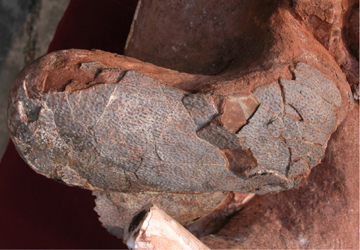 Because of
their three-pronged grasping claw configurations, oviraptors were named “egg
thieves,” but the dinosaurs’ reputation has in recent years shifted
from egg-stealing to egg-laying. And a new fossil from China illustrates exactly
how some of the species in the group laid their eggs.
Because of
their three-pronged grasping claw configurations, oviraptors were named “egg
thieves,” but the dinosaurs’ reputation has in recent years shifted
from egg-stealing to egg-laying. And a new fossil from China illustrates exactly
how some of the species in the group laid their eggs.The left egg of a pair found inside an oviraptor has led to some new ideas on how the dinosaur procreated. (The shell’s blue color is not original.) Image courtesy of Yen-nien Cheng.
A team of paleontologists, led by Tamaki Soto of the Canadian Museum of Nature in Ottawa, examined the pelvis of a female oviraptor that contained two immature eggs inside the body cavity. Each rough-textured egg is about the same size and shape as a pineapple, seated pointy-end up, and the two eggs’ similarity in size indicates that they were probably the same age.
The pairing indicates that the dinosaur, which is related to theropods, the group thought to be modern birds’ ancestors, had two working oviducts — as modern crocodiles do — but, like birds, only produced one egg at a time from each. Reporting in the April 15 Science, the authors say that the pointed eggs and their position in the animal’s pelvis also indicate that the females may have laid “neat, multilayered, ring-shaped clutches” of eggs that they built from the centers of their nests.

